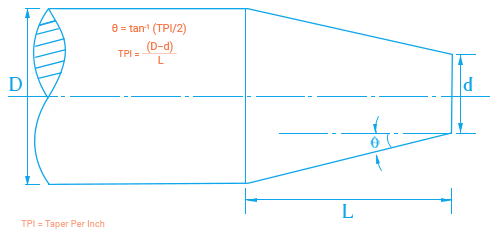Accurately calculate taper angles with our user-friendly Taper Calculator. Ideal for machinists and engineers.
In the complex world of making things precisely, accuracy is really important. One key thing people sometimes forget about is the taper angle. It's a measurement that has a big impact on how accurate the final product turns out.
Definition and Significance: Taper angle refers to the angle between the taper and the axis of rotation. In simpler terms, it's a measure of how much a section of an object narrows or broadens compared to another section.
This seemingly esoteric concept finds wide applications in various industries, ensuring uniformity and precision in the manufacturing process.
Applications in Manufacturing and Machining: From aerospace components to automotive parts, understanding and calculating taper angles is crucial for creating seamless and accurately fitting elements.
Manufacturers rely on taper angle calculations to guarantee the quality and performance of their products.

Basic Formula Overview
The mathematics behind taper angle calculation might seem daunting at first glance, but a basic formula provides a solid foundation. This section breaks down the formula, making it accessible even to those without an extensive mathematical background.
Factors Affecting Taper Angle
Taper angle is not a static value; it can be influenced by various factors. Exploring these factors not only deepens our understanding of taper angle but also sheds light on the intricacies involved in its calculation.
Calculation
Taper angle refers to the angle between the tapered surface and the horizontal plane. To calculate the taper angle, you need to know the dimensions of the tapered object and the angle of the tapered surface.
Taper per inch (TPI): The reduction in the cross-sectional diameter per inch of length. For a workpiece having taper length,
Assuming that the tapered object has a uniform taper, the taper angle can be calculated using the following formula:
For example,
if the diameter of the large end of the taper is 10 cm, the diameter of the small end is 5 cm, and the length of the tapered surface is 20 cm,
the taper angle can be calculated as follows:
Taper Angle = arctan ((10 - 5) / 20) = arctan (0.25) = 0.24498 radians
To convert the result to degrees:
Taper angle in degrees = 0.24498 x 180/π = 14.036 degrees
Therefore, the taper angle is approximately 14.036 degrees.
Manual Calculation Techniques: Before the digital age, engineers relied on manual methods for taper angle calculation. This section explores traditional techniques, providing a historical context for the evolution of calculation methods.
Introduction to Online Calculators: With technological advancements, online calculators have become invaluable tools for engineers. We introduce readers to the convenience and efficiency of using dedicated online calculators for taper angle calculations.
Accurate taper angle calculation directly translates to improved efficiency in manufacturing. This section elaborates on how precision in calculations positively impacts the overall production timeline.
Precision isn't just about time; it's also about resource optimization. Discover how accurate taper angle calculation minimizes material wastage, contributing to both economic and environmental sustainability.
The taper angle in a lathe can be calculated by dividing the difference in the diameter of the two ends of the taper by the length of the taper.
The taper length can be calculated by dividing the difference in the diameter of the two ends of the taper by the taper angle.
Taper angle finds applications in various industries beyond machining, including aerospace and automotive manufacturing.
While highly efficient, calculators may have limitations in extremely specialized applications, requiring additional considerations.